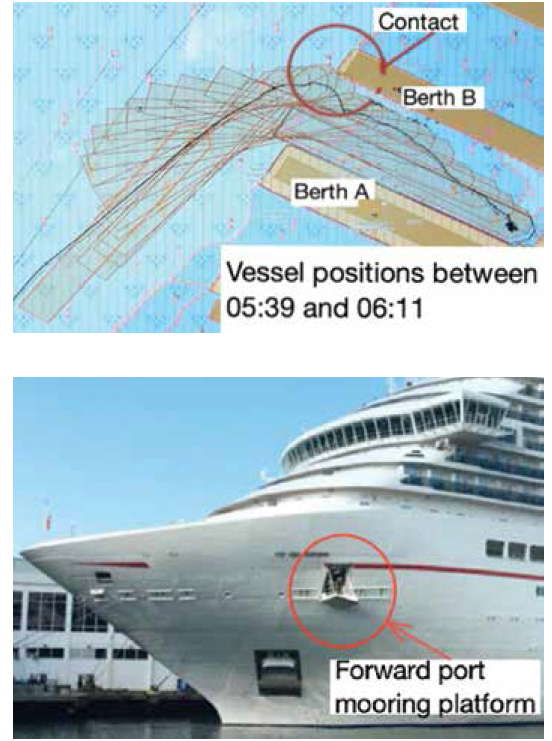202015 Passenger ship parking problems
As edited from NTSB (USA) official accident brief DCA18FM036
In the early morning hours a passenger vessel was inbound for the port with an arrival pilot at the con. There was a significant ebb tide setting at about 2.3 knots, so a docking pilot and assisting tug had been ordered. The docking pilot boarded and had a discussion with the Master about the docking manoeuvre. Shortly after this, the docking
pilot took the con from the arrival pilot.
The bridge team included the Master, Staff Captain, an officer, a cadet, lookout and helmsman. Additionally, an officer was stationed at the forward mooring platforms, port and starboard, to relay distances to berths A and B (see diagram below). About 15 metres separated the two platforms and the officer alternated from one to the other as needed.
The tug was positioned on the starboard side, without lines, to act as a pivot point for the starboard turn into berth A. The pilot gave helm and thruster orders and the Master complied using a controller. With the vessel’s speed at about 1.4 knots, the bow began approaching berth B. The officer forward gave a warning. The bow soon made contact with berth B, causing significant damage to two levels of the shoreside vehicle parking area.

The official investigation found, among other things, that:
- Minimum safe distances had not been set out during the docking discussions, so there was no shared mental model of where the threshold was.
- There was little evidence of the bridge team practising the technique of ‘thinking aloud’ that would have allowed for verbally sharing the mental model of the current and future situations.
- Members of the ship’s bridge team were not engaged effectively in helping the pilot and Master execute the manoeuvre.
- The officer at the forward mooring platforms had no view of the tip of the bow, which made contact with the parking structure. Also, he was doing double duty alternating from port to starboard, which reduced his effectiveness.
Editor’s comment: The marine industry is unusual in that, as in this example, up to five people have to co-ordinate their movements and actions in order to manoeuvre a massive floating object safely to berth. Since human error is understood to be the most prevalent contributory factor to accidents, these situations call for strict protocols and
procedural integrity; working as a true team is paramount. Working as individuals, each in their own bubble, is a recipe for failure.
